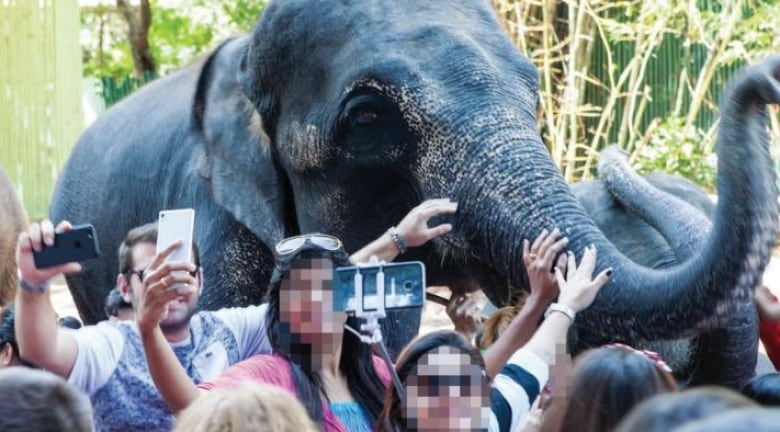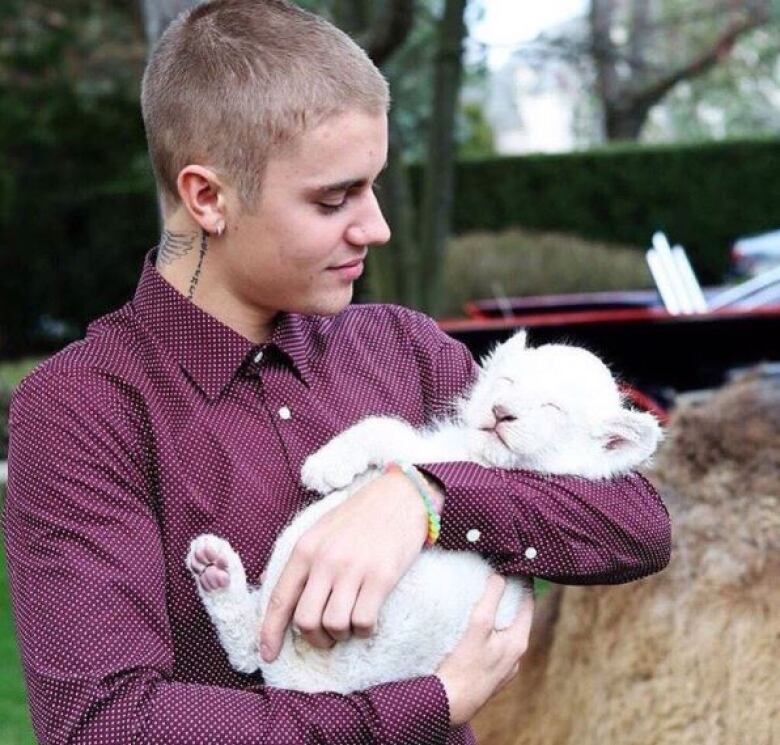Your wildlife selfies are hurting the animals, study finds
'Social listening' uncovers how we snap, post and share interactions with threatened, vulnerable species

UPDATE: On December 5, 2017, Instagram announced a new alert system to let users know the wildlife photos they're searching for may have contributed to harming animals.
When any of the site's 800 million users search or click on certain hashtags, like #slothselfie, they will get a pop-up message reading, in part, "Animal abuse and the sale of endangered animals or their parts are not allowed on Instagram."
Users will be able to click through to a dedicated page to learn more.
"We are encouraged by this first step towards changing the acceptability of using animals for our entertainment," Cassandra Koenen, of World Animal Protection, said in a statement. The organization said it contributed 94 suggested hashtags to Instagram.
ORIGINAL STORY:
Whether it's swimming with dolphins, feeding monkeys or riding elephants, our compulsion to snap, post and share wildlife selfies is contributing to the exploitation of animals.
That's the conclusion in a new report from World Animal Protection (formerly World Society for the Protection of Animals), which used a Canadian company's "social listening" research to analyze hundreds of thousands of images on social media.
While not all wildlife tourism is harmful, there are examples all over the world of animals being used for profit in ways that inflict suffering on them or endanger them.
"One of the biggest culprits is the growing popularity of wildlife selfies where tourists, with the help of tour operators, capture and share images of themselves with wild animals exploiting them as photo props," WAP says in the report released this week.
Good/bad selfies
WAP spokesperson Cassandra Koenen says users aren't necessarily ill-intentioned, they're just unaware.
"These are people who love animals, they want to have an authentic experience with an animal, and this just isn't it." Getting too intimate with animals for the purpose of taking photographsis "an attitude we need to change," she told CBC News.
Koenenpointed to two recent high-profile cases of dolphins dying after being mobbed by selfie-seeking tourists.
WAP commissioned Toronto-based Grassriots a marketing and advertising firm that specializes in social media advocacy campaigns to examinethe prevalence of wildlife selfies posted on social media.

Grassriots took an existing social media analytics platform called Crimson Hexagon typically employed by brands, companies or politicians to find out what people are saying about them and "trained" it for the purpose at hand by filtering results through tighter and tighter criteria that they defined.
"We were using the platform in a way that it has never been used before because these were categories that did not necessarily already exist," Zach Zimmel told CBC News. "Once we created our categories, we needed to employ a human coder to train the artificial intelligencemonitors to analyze the images according to our parameters."
By scanning Facebook, Twitter and Instagram posts through this combination of keyword search, image recognition and machine learning what they call trained social listening algorithms Grassriots narrowed down a sample size of 133,344 posts to 46,580 relevant ones.

Whereas a coffee shop might be looking for how often its logo shows up in social media posts, or how customers feel about its latest drink offering, WAP wanted to identify "goodselfies" (animals in their natural habitats who were not interacting with people) and "badselfies"images of tourists hugging, holding, touching, baiting or otherwise inappropriately interacting with animals in the wild.
They found that Instagram in particular is a vast gallery of animal exploitation, with its 800 million users worldwide posting an estimated 90 million photos each day.
Using the data, WAP calculated thatin the time period covered by the research, between 2014 and the present, there was a 292 per cent increase in the number of wildlife selfies posted on Instagram.The data also showed thatabout 40 per cent of the total number of wildlife selfiesare considered "bad selfies."
AnInstagramspokesperson told CBC News that users are prohibited from using the site to "facilitate or organize criminal activity that causes physical harm to animals" and that content is removed if it "promotespoaching of endangered species or the sale of animals for organized fight, and that includes acts of animal abuse."
Instagram is also "looking at ways to provide our community with information around activities that can be harmful to animals and nature, such as posting content that may depict exploitation of wildlife and bad welfare practices."
Celebs 'normalizing' the behaviour
The 10 most selfie'd animals:elephants, kangaroos, various primates, lions, tigers, sloths, koalas, dolphins, giraffes, turtles.
Some of them are listed as Appendix I, or threatened, on the international catalogue ofspecies, as are ocelots, manatees and other animals pictured in social media posts. Sloths are of particular concern even though they are not endangered. Some of the characteristicsthat make them such desirable photo subjects their slow pace and seemingly accommodating manner make them particularly vulnerable to human interaction.
By a wide margin, the largest proportion of wildlife selfiesoverall, according to Grassriots, were posted from locations or by users in the U.S. The fact that 41 per cent came from the U.S. ispossibly a reflection of the many social media megastars in that country.
There's Kim Kardashian cuddling a koala; Justin Bieber cradling a lion cub; Floyd Mayweather posing with his new pet tiger. These actions by celebrities, with their millions of followers, are exacerbating the problem, Koenen says.


"That's astronomical to be able to influence that many people, and so we need them to influence for good. We need them to stop normalizing this behaviour," she said.
WAP iscalling on social media networks to adjust their terms of service.
Twitter did not immediatelyreturn a requestfor comment from CBC News.
Facebook, in an email to CBC News, said it already has two policies that address the issue of animal cruelty. Its guidelines prohibit using the siteto "facilitate or organize"criminal activitythat causes physical harm to "people, businesses or animals."As well,graphic content shared "for sadistic pleasure or to celebrate or glorify violence" is forbidden.
Koenen says that's not enough.
"We're asking them to put some language in their community guidelines specifically around animal welfare," she said, and WAP wants to find ways tohelp educateusers on the issue.
A photo may not itself depict cruelty, Koenen says, but "it's the cruelty that happened leading up to this that's an issue for us."












_(720p).jpg)


 OFFICIAL HD MUSIC VIDEO.jpg)
.jpg)



























































































